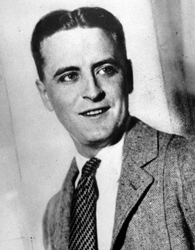F. Scott Fitzgerald was one of 20th century America’s greatest authors. His short stories and novels explored the wealth, hopes and moral indifference of the new-rich men and women of the 1920s, a time he dubbed the “Jazz Age.” His novel, “The Great Gatsby,” is an American masterpiece.
F. Scott Fitzgerald’s Early Days
Francis Scott Key Fitzgerald was born “into an upper-middle class family” on Sept. 24, 1896, in St. Paul, Minn. At the age of 2, Fitzgerald and his family moved to Buffalo, New York, where his father settled into a job with Proctor and Gamble. According to The Literature Network, “It was the first move of many that Francis would make during his lifetime.”
After his father lost his job, young Francis and his family returned to St. Paul where the 12-year-old enrolled in the St. Paul Academy. “Early on,” says The Literature Network, “he showed a love of the theatre and writing—his first work to appear in print was a detective story ‘The Mystery of the Raymond Mortgage’ (1909) in the Academy’s student paper ‘Now and Then.’”
In 1913, Fitzgerald was accepted to Princeton University. There he continued to hone his craft, though he never graduated. In 1917, Fitzgerald left Princeton to join the army and while stationed in Montgomery, Alabama, met his future wife, Zelda Sayre.
Discharged in 1919, Fitzgerald moved to New York City. There he wrote his first novel, “The Romantic Egoist,” which after three revisions was successfully published as “This Side of Paradise.”
Sources in this Story
- The Literature Network: F. Scott Fitzgerald
- All about F. Scott Fitzgerald: The novels
- Find A Grave: F. Scott Fitzgerald
- The New York Times: Scott Fitzgerald Looks Into Middle Age
- University of South Carolina Libraries: F. Scott Fitzgerald Centenary
Fitzgerald’s Notable Accomplishments
Starting in the 1920s, Fitzgerald began to make a profound and lasting mark on the American literary scene. In 1922, he published “The Beautiful and Damned.” With this work, Fitzgerald “wanted to prove himself as a ‘serious author,’” says the web site All About F. Scott Fitzgerald, but he may have “drove some of his points home with too much emphasis.” Three years later, he penned his masterpiece, “The Great Gatsby.”
Now considered an American classic, the story revolves around the young Jay Gatsby, an ordinary soldier who gets rich in order to impress a wealthy girl he has fallen in love with. Narrated by Nick Carraway, the story examines beauty and wealth in the face of moral indifference. “Never before and never again was Fitzgerald’s writing so precise and so beautiful at the same time.”
Fitzgerald’s effort made an immediate impression on literary critics. In 1925, The New York Times wrote of “The Great Gatsby” that it was “A curious book, a mystical, glamourous story of today. It takes a deeper cut at life than hitherto has been enjoyed by Mr. Fitzgerald. He writes well—he always has—for he writes naturally, and his sense of form is becoming perfected.”
Fitzgerald went on to publish “Tender is the Night” in 1934, and “The Love of the Last Tycoon” in 1940, before dying of a heart attack at the age of 44. But with the country mired in economic depression, his tales of extravagance and moral indifference had fallen on deaf ears.
F. Scott Fitzgerald and His Work
- “The Great Gatsby” by F. Scott Fitzgerald
- “The Curious Case of Benjamin Button” by F. Scott Fitzgerald
- “This Side of Paradise” by F. Scott Fitzgerald
- “Tender is the Night” by F. Scott Fitzgerald
- “The Love of the Last Tycoon” by F. Scott Fitzgerald“
The Rest of the Story
Fitzgerald was buried at Rockville Union Cemetery in Rockville, Maryland, in December 1940. Today it is the most visited site in the cemetery.
Some have painted Fitzgerald as an “uncritical reveler,” a man who “scribbled his masterpieces during the course of a lifelong bender,” making light of his love of drink and his high-flying lifestyle. Nevertheless, Fitzgerald’s stories are “a classic study of the American Dream in all its highs, lows, excesses, and joys.”
As Matthew J. Bruccoli, a renowned Fitzgerald expert, notes, “His life frequently overshadows his work as he has become an archetypal figure or a cluster of overlapping archetypes: the drunken writer, the ruined novelist, the spoiled genius, the personification of the Jazz Age, the sacrificial victim of the Depression.” But Fitzgerald, Bruccoli concludes, “was a hero with many flaws, but a hero.”
This article was originally written by Vinnie Rotondaro; it was updated September 15, 2017.











